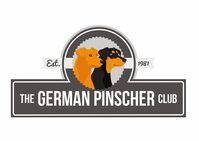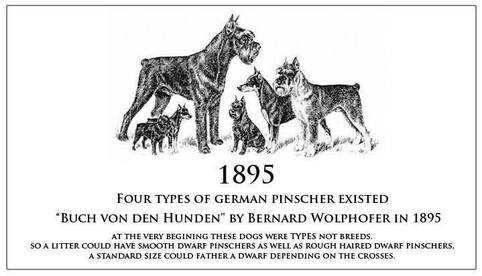The History of the German Pinscher
|
With kind permission from the Pinscher-Schnauzer Klub
|
The German Pinscher originated in Germany in the 19th century and was used as a stable-dog to protect, guard and to exterminate vermin. As a working dog German Pinschers were known for their vermin hunting skills and instinctual desire to protect the home and family. The breed was defined in 1880 and in 1895 Josef Bertha founded the “Pinscher Klub” in Germany. The first breed Standard was written in 1884 and revised in 1895 when the German Pinscher was officially recognised as a distinct breed (after years of breeding for a short-haired dog). At that time the Pinscher colours varied widely. Both German Pinschers and Standard Schnauzers (which were also being bred for coat type during this period) are descendants of the Rat Catcher, Great Ratter, or Rat Pinscher which became extinct in the 1800’s. The German Pinscher was one of the foundation breeds in the development of the Dobermann and Miniature Pinscher breeds in Germany during the late 1800’s.
|
The German Pinscher was not as popular as his next of kin the Schnauzer (rough-haired pinscher). From 1939 (the beginning of the 2nd world war) the German Pinscher breed declined in numbers; and in 1949 the last German Pinscher litter was whelped in West Germany and entered into the stud-book. No litters were subsequently born until 8-9 years later, the breed had almost become extinct.
In 1957 Werner Jung was the breed-supervisor of the German Pinscher-Schnauzer-Klub , he undertook the task to save the German Pinscher from extinction – laying the foundation for the modern German Pinscher breed. He obtained a black and tan bitch of pure breeding - 'Kitty v. Bodenstrand' and another black and tan bitch called 'Jutta". Through strict selective breeding of some oversized miniature pinschers for stud dogs, he bred a small basis of German Pinschers under his kennel name ‘v/d Birkenheide’.
German Pinschers in the UK
Blista's Story
|
Roy & Marion Collicott and Donald & Heather Smith had planned a weekend away in the Spring of 1979, they went to Amsterdam to the All Winners Show and to visit the sights. They all walked around Amsterdam's beautiful city so much that Roy Collicott developed a blister.
At the All Winners Show they had gone to view the Miniature Pinschers which they were all involved in at the time. During this show they noticed in the ring beside them there were larger Pinschers, intrigued they found out they were "Deutscher Pinschers" or as we now refer to them "German Pinschers". Further enquiries introduced them to Mr Van Giniken (who they later discovered was Secretary of the Club), he was only too pleased to tell them all about the breed, and invited them all back to his home in Eindhoven. The following day they travelled by train to meet the breeder where they received a very warm welcome from the dogs and Mr Van Giniken’s family. They were instantly smitten with the dogs and the one week old litter they met. This was the first sight of a little red bitch that was to come to the UK, whose name would be name ‘Blista’. She was later imported and spent 6 months in quarantine at Ruislip (pictured opposite Blista in the UK in 1980) |
The first German Pinscher in the UK - 1980 Blista V Werner Junghof, Dutch Import Breeder Mr Marinus Van Giniken |
This was the start of German Pinschers as a breed in the UK, and very soon after they returned to Eindhoven to select a black and tan dog; his name was ‘Boris V Werner Junghof’ (Mr Van Giniken had left the ears natural so ‘Boris’ could be shown in the UK). He also agreed to let a bitch come over in whelp ‘Daphnie V Werner Junghof’, she had her puppies in quarantine (sadly 2 died at birth), there were 2 boys: a red and a black and tan and 2 bitches; a red and a blue and tan. This was first ever litter born in the UK - the Amsta litter. (The Collicott's kept the 2 boys, the blue and tan bitch went to the Smith's and the red bitch went to the Whitehorn's).
The very first meetings of The German Pinscher Club were held in the Collicott's sitting room, the first people to be involved were Roy & Marion Collicott, Donald & Heather Smith, Joan Cain & Mr Lawrence. Later John Brewing, Frank & Gloria Cuthbert, Allan & Isobel Legget, Kathy Rafatjah, Judy Entwhistle & Erica Mainprise joined. The club was formed in 1981 and recognised by the Kennel Club in 1988. For the first few years at dog shows 'Not Separately Classified' were the only classes German Pinschers could enter, never the less they held their own in the show ring. The first German Pinschers to qualify and exhibit at Crufts were the Legget’s Tubize Buccaneer - blue and tan dog and the Smith’s Tubize Hally - black and tan bitch. Over the next few years more dogs entered and qualified and the club now worked towards classes of its own at Championship shows. German Pinscher classes at that time could reach 30 dogs or more. From Scotland down to Devon German Pinschers the could exhibit in classes.
The very first meetings of The German Pinscher Club were held in the Collicott's sitting room, the first people to be involved were Roy & Marion Collicott, Donald & Heather Smith, Joan Cain & Mr Lawrence. Later John Brewing, Frank & Gloria Cuthbert, Allan & Isobel Legget, Kathy Rafatjah, Judy Entwhistle & Erica Mainprise joined. The club was formed in 1981 and recognised by the Kennel Club in 1988. For the first few years at dog shows 'Not Separately Classified' were the only classes German Pinschers could enter, never the less they held their own in the show ring. The first German Pinschers to qualify and exhibit at Crufts were the Legget’s Tubize Buccaneer - blue and tan dog and the Smith’s Tubize Hally - black and tan bitch. Over the next few years more dogs entered and qualified and the club now worked towards classes of its own at Championship shows. German Pinscher classes at that time could reach 30 dogs or more. From Scotland down to Devon German Pinschers the could exhibit in classes.
The clubs first club show was at Ranby in 1988 and Mr Van Giniken was asked to judge, Best of Breed and Best Puppy was Jones’s Miaroi Red Romance. After this the club ran two club shows a year which were well supported and also became a social occasion, the AGM was held at one and a demonstration of obedience was held at the other, many pinschers took part in this and proved they were very good at this activity. In 1990 Herr Schneider from Germany was asked to judge the club show and Best of Breed was Holliday’s Chartis High Flyer, and Best Puppy was Legget’s Roheka Red le Baron at Swanwite.
More imports then followed into the UK (all imports had to spend 6 months in quarantine at that time which took its toll on the dogs and was a huge a cost to the owners) including Legget's Cains Ulysses Von Selbeck Uklei, Ger. Ch Schelm Von Cronsbach & Felia Von Cronsbach at Swanwite, Rafatjah's Pinch Hits Charity, Smith & Collicott's Viking II Von Werner Junghof, Cuthbert's Luxlor Bentley at Kinrha and Morrison's Dorthonion Merimac at Lankirk .
In the early 2000's the club, showing and breeding was going through a quiet time, however the club continued with the dedicated members who still run it today. A new infusion was on its way and from 2009 (changes in quarantine laws influenced this) dogs were being imported from Finland, USA, Sweden, Germany, Poland and France and the breed had an a new influx of members and dogs which then saw growing interest in the breed throughout the country.
More imports then followed into the UK (all imports had to spend 6 months in quarantine at that time which took its toll on the dogs and was a huge a cost to the owners) including Legget's Cains Ulysses Von Selbeck Uklei, Ger. Ch Schelm Von Cronsbach & Felia Von Cronsbach at Swanwite, Rafatjah's Pinch Hits Charity, Smith & Collicott's Viking II Von Werner Junghof, Cuthbert's Luxlor Bentley at Kinrha and Morrison's Dorthonion Merimac at Lankirk .
In the early 2000's the club, showing and breeding was going through a quiet time, however the club continued with the dedicated members who still run it today. A new infusion was on its way and from 2009 (changes in quarantine laws influenced this) dogs were being imported from Finland, USA, Sweden, Germany, Poland and France and the breed had an a new influx of members and dogs which then saw growing interest in the breed throughout the country.




